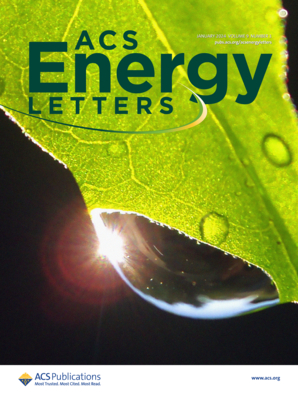Surface Engineered BiVO4 for Photoelectrochemical Alkene Epoxidation via Bromine Mediation
IF 18.2
1区 材料科学
Q1 CHEMISTRY, PHYSICAL
引用次数: 0
Abstract
Selective epoxidation of alkenes is essential in organic synthesis, yet achieving it under mild conditions presents significant challenges. Photoelectrochemical (PEC) alkene epoxidation driven by hypobromite (BrO–, Br+) formation offers a green and sustainable route, and enhancing Br+ production is essential for achieving high product selectivity. A synergistic strategy that integrates water oxidation to hydrogen peroxide with bromide oxidation to bromine (Br2) using a surface engineered BiVO4 photoanode is presented. In situ generated H2O2 and Br2 yield BrO–, which serves as an active brominating (Br+) agent for alkene epoxidation. Consequently, the surface engineered BiVO4 photoanode achieves over 98.1 ± 0.79% conversion rate and 91.9 ± 0.99% selectivity across various alkenes. An unbiased PEC tandem device is constructed by coupling a BiVO4 photoanode for styrene epoxidation with a Cu2O photocathode for hydrogen production, achieving simultaneous styrene oxide production with 86.4% selectivity and hydrogen production. Our work provides new insights into PEC organic synthesis and hydrogen production.

表面工程BiVO4在溴介质下的光化学烯烃环氧化
烯烃的选择性环氧化在有机合成中是必不可少的,但在温和的条件下实现它提出了重大的挑战。次溴酸盐(BrO -, Br+)驱动的光电化学(PEC)烯烃环氧化反应提供了一条绿色可持续的途径,提高Br+的产量是实现高产品选择性的必要条件。提出了一种利用表面工程BiVO4光阳极将水氧化成过氧化氢与溴氧化成溴(Br2)集成在一起的协同策略。原位生成H2O2和Br2生成BrO -,作为烯烃环氧化的活性溴化(Br+)剂。因此,表面工程BiVO4光阳极在各种烯烃上的转化率超过98.1±0.79%,选择性超过91.9±0.99%。通过将BiVO4光阳极与Cu2O光阴极耦合,构建了无偏PEC串联装置,实现了苯乙烯环氧化反应的选择性为86.4%,同时产氢。我们的工作为PEC有机合成和制氢提供了新的见解。
本文章由计算机程序翻译,如有差异,请以英文原文为准。
求助全文
约1分钟内获得全文
求助全文
来源期刊

ACS Energy Letters
Energy-Renewable Energy, Sustainability and the Environment
CiteScore
31.20
自引率
5.00%
发文量
469
审稿时长
1 months
期刊介绍:
ACS Energy Letters is a monthly journal that publishes papers reporting new scientific advances in energy research. The journal focuses on topics that are of interest to scientists working in the fundamental and applied sciences. Rapid publication is a central criterion for acceptance, and the journal is known for its quick publication times, with an average of 4-6 weeks from submission to web publication in As Soon As Publishable format.
ACS Energy Letters is ranked as the number one journal in the Web of Science Electrochemistry category. It also ranks within the top 10 journals for Physical Chemistry, Energy & Fuels, and Nanoscience & Nanotechnology.
The journal offers several types of articles, including Letters, Energy Express, Perspectives, Reviews, Editorials, Viewpoints and Energy Focus. Additionally, authors have the option to submit videos that summarize or support the information presented in a Perspective or Review article, which can be highlighted on the journal's website. ACS Energy Letters is abstracted and indexed in Chemical Abstracts Service/SciFinder, EBSCO-summon, PubMed, Web of Science, Scopus and Portico.
 求助内容:
求助内容: 应助结果提醒方式:
应助结果提醒方式:


